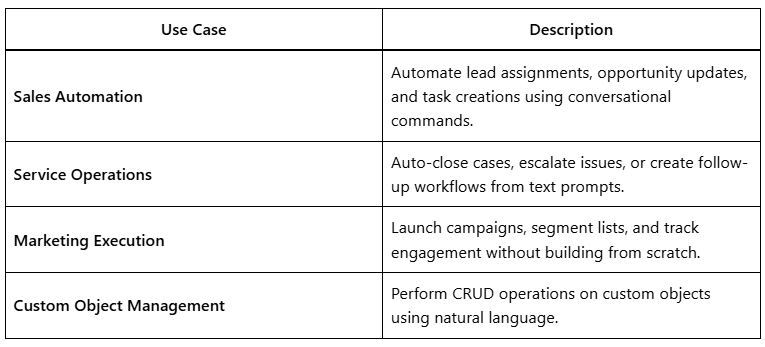What is Salesforce Large Action Model and New AI Agent Testing Tools

Salesforce, a pioneer in cloud-based CRM, continues to revolutionize enterprise workflows with the integration of artificial intelligence. With the introduction of the Large Action Model (LAM) and AI Agent Testing Tools, Salesforce is now offering a new level of automation and intelligent agent interaction for business processes. These innovations are reshaping how users interact with Salesforce by enabling systems to not only understand natural language but also take decisive and safe action within the platform.
This comprehensive blog explores the Large Action Model, its capabilities, use cases, and how the newly introduced AI Agent Testing Tools ensure safe, reliable, and predictable performance in enterprise environments.
Table of Contents
What is the Large Action Model (LAM)?
The Large Action Model (LAM) is Salesforce’s proprietary, enterprise-grade AI model built to execute complex, multi-step tasks inside the Salesforce ecosystem. Unlike generic large language models (LLMs) that focus on generating human-like text, LAM is action-centric. It is designed to interpret natural language instructions and convert them into actual Salesforce actions, such as creating tasks, updating records, triggering flows, and more.
Where traditional AI in Salesforce focused on insights (like predictive scoring or summarization), LAM focuses on doing it turns human intent into enterprise actions.
Key Characteristics of LAM
1. Action-First Design
Unlike LLMs trained to predict the next word, LAM is trained to predict the next action, allowing it to perform updates, create records, and automate tasks based on natural language commands.
2. Multi-Step Reasoning
The model can handle tasks involving multiple steps, understanding dependencies, and sequencing operations accurately.
3. Context-Aware Execution
LAM uses metadata from your Salesforce org (like custom fields, objects, and user roles) to tailor its actions, ensuring contextual accuracy.
4. Trust Layer Integration
Security is embedded at its core. LAM respects org-level permissions, field-level security, data access policies, and audit trails.
5. Flow + Apex Integration
LAM can invoke flows and Apex classes seamlessly, allowing it to bridge declarative and programmatic automation tools.
How the Large Action Model Works
Step 1: Understand Intent
The user provides a natural language input, such as
“Reassign all open opportunities in the healthcare vertical to the regional manager.”
Step 2: Interpret Data Context
LAM accesses the org schema and identifies
- Object: Opportunity
- Filters: Industry = Healthcare, Stage = Open
- Action: Update Owner
Step 3: Execute with Safety
LAM performs the update while:
- Logging the activity
- Validating against user permissions
- Respecting automation rules and triggers
Real-World Use Cases for LAM

Example:
“Create a follow-up task for every lead contacted in the last 7 days with a score above 70.”
LAM translates this into:
- SOQL Query on Leads
- Task creation
- Owner assignment
- Deadline scheduling
Rise of AI Agents in Salesforce
As part of Salesforce’s broader AI strategy, AI Agents are intelligent software entities powered by LLMs, decision engines, and platform metadata. These agents autonomously complete tasks or guide users based on natural input.
What Can AI Agents Do?
- Interact via Einstein Copilot in the UI or Slack.
- Execute Flows or Apex logic
- Analyze CRM data and suggest actions.
- Respond to customers with knowledge base information.
- Automatically resolve service tickets.
Agents rely on LAM to convert understanding into action. They function not just as responders, but as doers.
Introduction to AI Agent Testing Tools
As AI agents grow more autonomous, testing them becomes critical. Salesforce has introduced robust AI Agent Testing Tools to allow developers, admins, and testers to:
- Simulate agent behavior
- Validate decision-making
- Trace action sequences
- Mitigate risks before deployment.
These tools bring DevOps-like rigor to AI automation.
Features of Salesforce AI Agent Testing Tools
1. Agent Simulation Environment
Developers can run agents in a sandbox-like environment that mimics live data but with controlled conditions. This prevents data corruption and allows safe experimentation.
2. Trace and Audit Logs
Every interaction by an AI agent is logged. Users can inspect:
- The prompt received
- Actions taken
- Data queried
- Results and errors
This traceability is key to understanding why an agent took specific steps.
3. Human-in-the-Loop Feedback
Users can provide feedback on AI Agent behavior. For example, if an agent incorrectly assigns leads, a reviewer can flag this and fine-tune the response model or its permissions.
4. Custom Test Scenarios
Teams can define test cases.
- Input: Prompt to agent
- Expected: Actions and outputs
- Result: Pass/fail with diagnostics
This allows regression testing over time.
5. Fail-Safe Handling
Agents can be configured to:
- Escalate to a human
- Log an error.
- Abort the chain of actions.
- when uncertain or encountering ambiguous prompts.
Real-Life Testing Workflow Example
Use Case: Auto-assigning High-Value Leads
1. Scenario Definition:
“Assign leads from Europe with a score >80 to the senior manager group.”
2. Test Steps:
- Define sample leads in sandbox.
- Trigger agent simulation with prompt
- Monitor query and update behavior.
3. Expected Outcome:
- Correct leads are identified.
- Owner updated
- Task created for follow-up
4. Validation:
- Review logs
- Compare against expected results.
- Send feedback to refine the model if needed.
Business Benefits of LAM and Agent Testing Tools
1. For Admins & Developers
- Save time building Flows and Apex code.
- Use natural language to define automation.
- Debug agents using trace logs.
- Reduce manual QA and regression cycles
2. For Business Users
- Empower self-service: no need for dev support
- Speak to Salesforce using natural language.
- Get faster outcomes across sales, service, and marketing.
3. For IT and Compliance
- Full visibility into AI agent actions
- Enforce permission models and access controls.
- Validate agent reliability before production rollout.
Integration with the Salesforce Platform
1. LAM and AI agents work across all major Salesforce Clouds:
- Sales Cloud: Automate pipeline management
- Service Cloud: Intelligent case routing and resolution
- Marketing Cloud: Dynamic campaign generation
- Slack + Flow: Agents triggered in conversation channels
2. They also integrate with:
- Flow Builder for action execution
- Apex classes for custom logic
- DevOps Center for version control and CI/CD testing
- Sandbox environments for safe experimentation
What’s Next for LAM and AI Agent Testing?
Salesforce is expected to expand LAM and agent tooling in the coming releases.
1. Large Action Model Enhancements
- Improved org-level fine-tuning
- Enhanced support for custom metadata
- More granular access to Flow templates
- Unified orchestration across Salesforce apps
2. Testing Tools Enhancements
- UI-based test case builder
- Auto-suggested corrections from failed tests
- Real-time performance benchmarking
- AI-generated test coverage reports
Conclusion: Salesforce Large Action Model and New AI Agent Testing Tools
Salesforce is ushering in a new era of AI-powered enterprise automation, where actions speak louder than words and the words themselves are the commands.
The Large Action Model redefines what AI can do inside Salesforce. Instead of just analyzing or predicting, it executes with intelligence. When paired with robust AI Agent Testing Tools, Salesforce ensures this power is governed, traceable, and enterprise-safe.
These tools don’t just automate; they augment human capability, making every user, from admins to agents, more productive and strategic.

